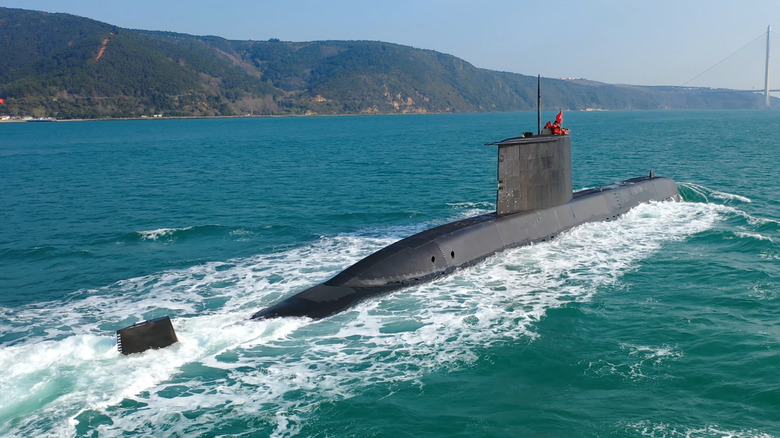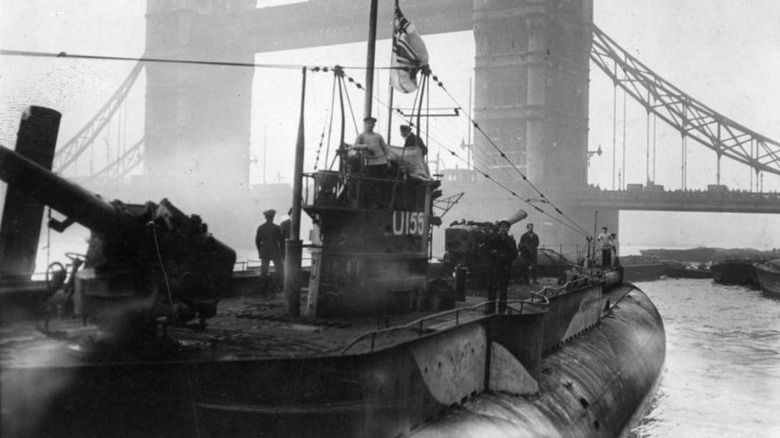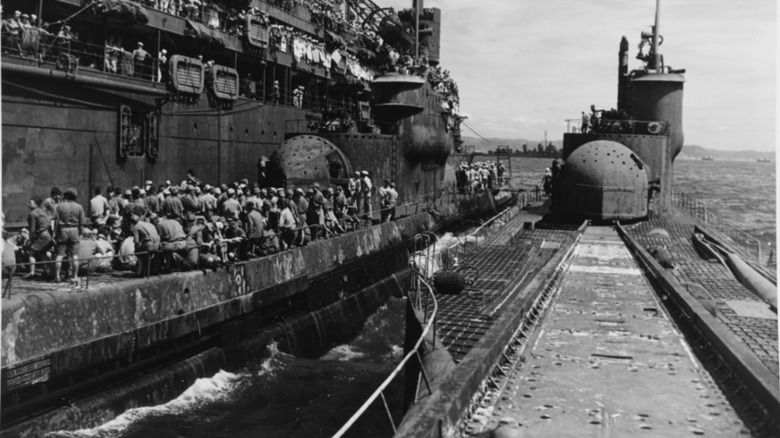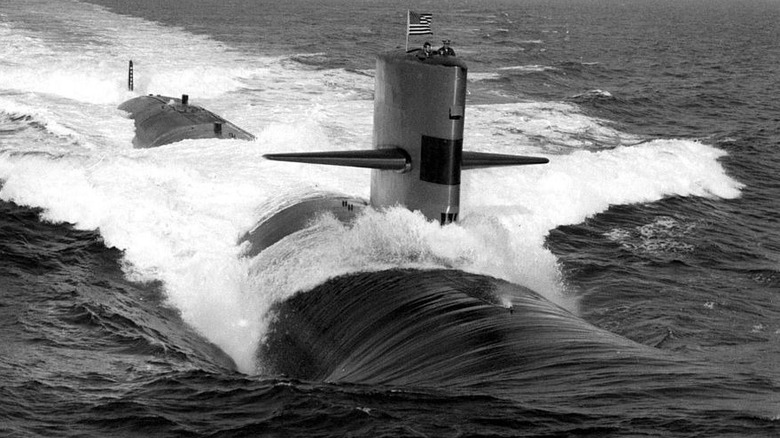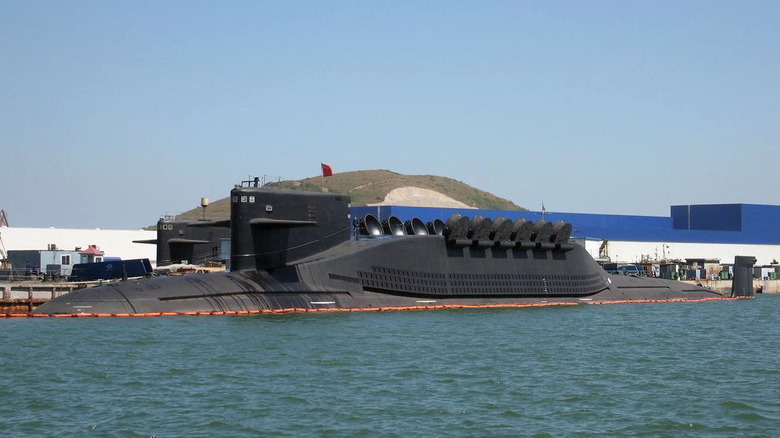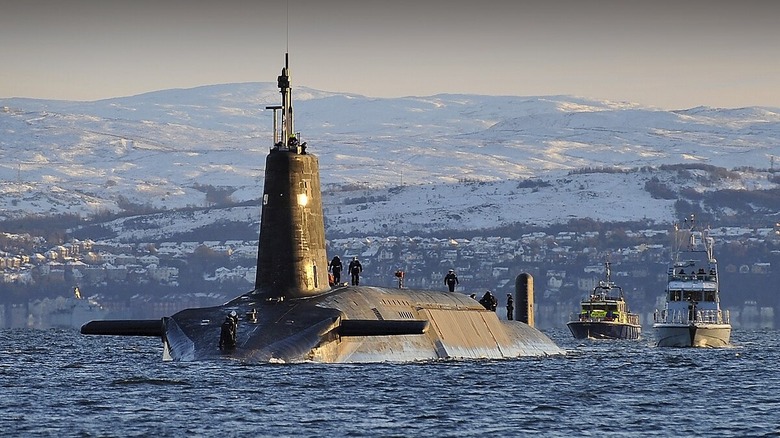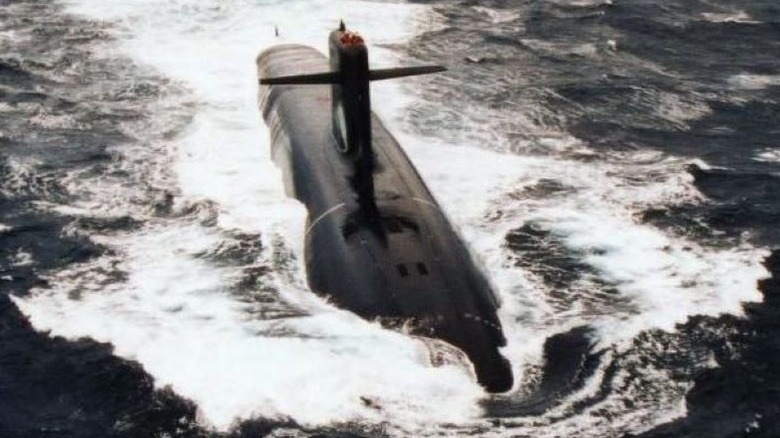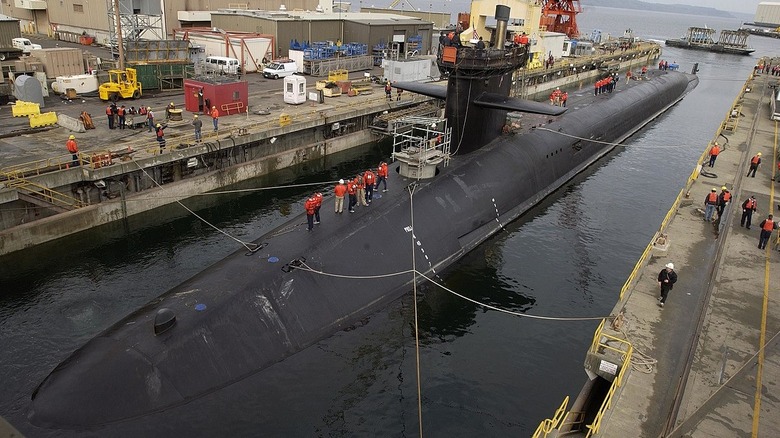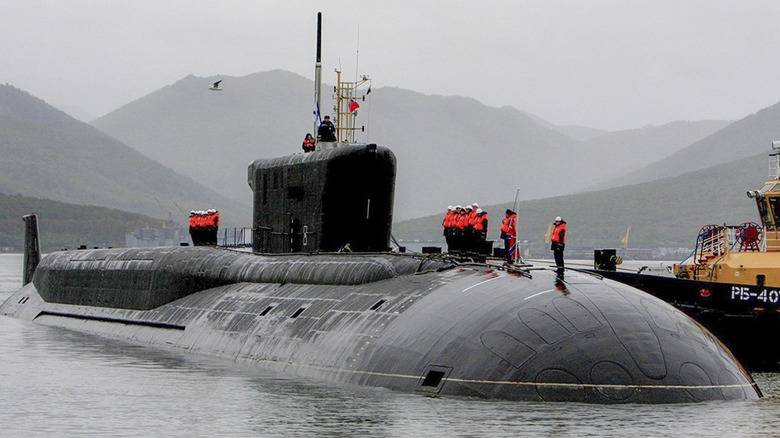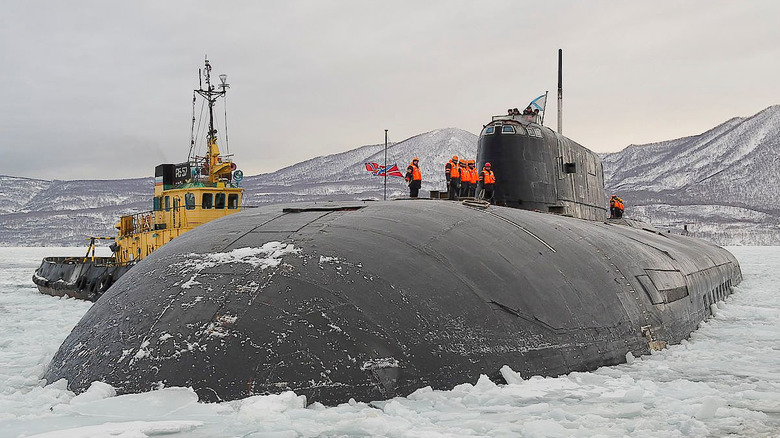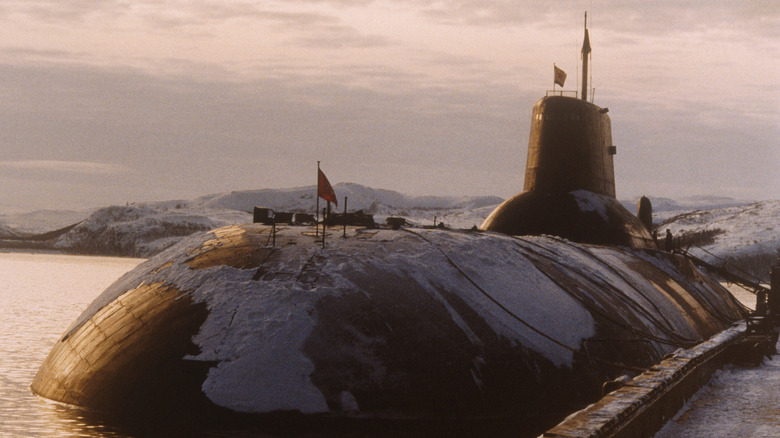10 Of The Biggest Military Submarines Ever Made
The science of submarines has grown exponentially since the CSS Hunley sank the USS Housatonic on February 17, 1864. The Hunley was the first military submarine to sink an enemy target, but the evolution of the submarine goes back further than you may think. Humans have been experimenting with underwater travel for a long time, and recent years have seen explosive growth in submarine technology and capability.
The 20th century was defined by the rise of the submarine. From rudimentary boats that would surface to demand the surrender of helpless merchant ships to the savage undersea combat of World War II to nuclear-powered behemoths with virtually unlimited range, submarines have changed the geopolitical and military face of international relations.
In the decades of experimentation that broadened sub capability, almost no idea was too outlandish. This resulted in some wild designs, including submarines with 50-ton battleship guns mounted on them, single-pilot suicide subs akin to an undersea kamikaze, and submarines with aircraft hangars. This article isn't about weirdness (though there is undoubtedly some within). It's about big, and some of these submarines qualify as gargantuan. While the earliest submarines can't compare in size to the most modern iterations, we take a peek into the past to provide a perspective of how far submarine construction has come since its earliest days. Join us as we explore the purpose, service, and features of some of the biggest military submarines ever made.
U-151 class
Though the Hunley scored the first submarine victory in 1864 — killing itself in the process — the real heyday of submarine warfare arrived during the First World War, 50 years later. Both sides had experimented with submarines before the war, but Germany flexed its engineering prowess with an Unterseeboot, or U-boat, fleet that changed the course of history.
The largest submarine of the era was the Type U-151. It was initially designed as a long-range cargo vessel meant to traverse the oceans without danger of interception. It performed this task reasonably well, even making commercial voyages to the United States before its entry into the war. The U-151 boats prioritized space as cargo vessels, resulting in submarines that were quite large for their day. With a crew of 35 and the ability to remain submerged for up to two hours, the boats were 315 feet in length and could carry up to 700 tons. Typical combat submarines were nearly 100 feet shorter.
The German navy converted U-151s to combat duty as the war became increasingly desperate. In 1917, it transformed the seven survivors of the type into armed cruisers. It would prove too little, too late for the Imperial Navy. The writing was on the wall by the time American forces reached Europe in June 1917.
I-400
Thirty years later, World War: The Sequel premiered on battlefields worldwide. This time, all belligerents fielded substantial submarine fleets. The era's largest was Japan's I-400 class. Known as the Sen Toku, these subs measured 400 feet long, 39 feet wide, and 23 feet tall, displacing 6,560 tons underwater. They were 88 feet longer than the contemporaneous American Balao-class submarine and longer than the American Fletcher-class destroyer surface ship.
While those specifications were impressive for the day, the I-400's headline was that it doubled as an aircraft carrier. No, it didn't launch a fleet of planes, but it could carry up to three Aichi M6A1 Seirans, which could perform reconnaissance or offensive operations and carry up to 1,800 pounds of torpedoes and bombs. The I-400's enormous size lent itself to its immense range — it could travel 37,500 miles, or one and a half times around the planet, without refueling. That mark has yet to be beaten by a diesel-electric submarine. The I-400 remained the largest submarine ever built until the nuclear-powered boats of the 1960s emerged.
The Sen Toku's primary mission was to attack American-controlled coastal areas. At least one was assigned to disrupt the Panama Canal, a critical supply route for the United States Navy. The plan was to launch the three aircraft to attack the lock gates. Disabling them would prevent the United States from transiting the canal, leaving its Pacific Fleet undersupplied as ships would have to reroute around South America. It never got its chance, nor did its sister ships. The first I-400 joined the fight in December 1944. The attack on Okinawa in April 1945 put American forces within striking distance of Japan. The I-400s would be needed for homeland defense. A few months later, the war was over.
USS Glenard P. Lipscomb
The nuclear attack on Japan in August 1945 didn't just mark the end of the Second World War. It marked the opening of the atomic age — one which would mark a sea change (pun absolutely intended) in the construction of submarines. That's because it opened the door for nuclear-powered submarines.
Up until the advent of nuclear reactors as power plants, a submarine operated on diesel-electric engines, a configuration that demanded periodic surfacing. As the Cold War heated up, American nuclear-powered submarines began to ply the seas, limited in range and submersion time only by food supplies.
Similar to the Sturgeon-class submarines, the USS Glenard P. Lipscomb was a one-of-one nuclear-powered boat designed to serve as a test bed. At 365 feet long, with a 32-foot beam, and displacing 6,480 tons of water when submerged, it was among the largest U.S. nuclear submarines at the time. It was ordered on December 16, 1968, and commissioned on December 21, 1974. Though the Lipscomb was a combat-capable attack sub, it was primarily used to test a turbo-electric drive propulsion system in an attempt to make subs quieter. It retired from service in September 1989.
Jin class
China has been investing a lot of sweat and treasure into developing its military power. Part of that equation is joining the ranks of ballistic missile submarine operators. Meant to replace the notoriously unreliable Xia-class sub, the keel of the first Jin-class Chinese sub was laid down in the early 2000s, with commissioning following a few years later.
At 442 feet long with a 41-foot beam, the Jin-class displaces approximately 11,000 tons of water when submerged. Meant as a nuclear deterrent, the Jin carries up to a dozen JL-2 submarine-launched ballistic missiles (SLBMs). Each mounts a single warhead and has a range of up to 5,600 miles. Launched from territorial waters, the missiles pose a potential threat to U.S. territories like Guam and states like Alaska and Hawaii.
However, the Jin is maligned as a noisy submarine, a characteristic that makes it relatively easy to detect by America's extensive sensor and defense network. This vulnerability is a significant factor in the Jin's operational limitations.
Vanguard class
The United States wasn't alone in countering Soviet power. The British Royal Navy fielded (oceaned?) a nuclear submarine that eclipsed even the I-400: the Vanguard-class submarine. An atomic sub equipped with Trident II nuclear missiles, England laid the keel for the first Vanguard in 1986, though its origins lie with the previous-generation Resolution-class subs of the 1960s.
The lead ship, HMS Vanguard, hit the ocean in August 1993, followed by HMS Victorious in early 1996, HMS Vigilant in November 1996, and HMS Vengeance in 1999. Measuring 491 feet long with a beam of 42 feet, each Vanguard displaces 17,500 tons of water when fully submerged. Some might argue that Rolls-Royce's most powerful vehicle ever is the Black Badge Spectre, but we beg to differ. Vanguards use a Rolls-Royce PWR2 nuclear reactor to provide 27,500 shaft horsepower. Not bad compared to the 659 hp Spectre. Then again, the Spectre hits speeds of 155 mph, while Vanguards manage a measly 29 mph – still in the range of some of the fastest submarines around.
Given those performance specs, it's hard to see why the Vanguards cost approximately $4.85 billion more than the Spectre. It could be because the Spectre doesn't include nuclear weapons, which the Vanguards have in spades. An armament of up to 16 Lockheed Trident II DF SLBMs and a quartet of 21-inch missile tubes makes the Vanguards some of the biggest, baddest subs on the planet. All four are still in use by the British Royal Navy.
Triomphant class
Building a nuclear-powered vessel requires an incredible amount of resources. Only a handful of nations have done so, primarily as aircraft carriers. The United States, Russia, France, the United Kingdom, India, and China have all developed warships with nuclear reactors. The Triomphant-class submarine built by the French is one of the largest boats of the atomic era.
Built in Cherbourg, France, the first Triomphant was launched in July 1993. Like the Vanguards, the first Triomphant was named after its class, while three of its siblings came later: Le Temeraire in 1997, Le Vigilant in 2004, and Le Terrible in 2010. With a length of 453 feet and a beam of 41 feet, the Triomphants displace 14,335 tons of water when submerged, putting them in close company with the Vanguards in terms of size. Each can remain submerged for up to 60 days.
The early Triomphant arsenal included 16 vertically launched M45 SLBMs equipped with thermonuclear warheads. The missiles have a range of up to 3,700 miles and can deliver six 150-kiloton nuclear smackdowns. The most recent Triomphant, the aptly named Le Terrible, uses updated M51 missile systems, which have an increased range of 5,000 miles.
Ohio class
When it comes to bigger is better, the United States likes to put up a good fight. Its Ohio-class submarines, with their immense power and capabilities, overshadow the attempts of the British and French. Conceived in the early 1970s as an all-new class of submarine, construction on the first Ohio began in April 1976 in Groton, Connecticut.
Like many others on this list, the Ohio is a boomer sub — and no, that doesn't mean it wants you to stop buying avocado toast. Boomer is slang for ballistic missile submarines designed for nuclear deterrence — because they can make a big boom, get it? — as opposed to attack submarines used for hunting ships. First prize goes to anyone who can guess the name. Ohio? We've got a winner. The USS Ohio joined the fleet in November 1981 as the first of a class that would eventually grow to 14 submarines. At a length of 560 feet and with a beam of 42 feet, each Ohio displaced 18,750 tons of water submerged and could hit up to 23 mph.
A crew of 140 enlisted men and 15 officers operate and maintain a single nuclear reactor and up to 24 Trident II SLBMs, in addition to Mk 48 torpedoes via four torpedo tubes. Though older, the arsenal aboard the Ohio outstrips those of the Vanguard and Triomphant boats. But hey, it's America, that's what it does.
Borei class
We've spoken quite a bit about the submarines of the West, but we mustn't overlook the fact that the United States, France, and England were building them for a reason. That reason was the Union of Soviet Socialist Republics. After all, what is brinksmanship without a good rival? It would be impossible not to include the Soviet Union in this article because it was extraordinarily accomplished in building absolutely enormous submarines.
The Borei class was the first submarine developed after the fall of the Soviet Union, when we all went back to calling it Russia. Borei was in the design phase throughout the 1980s and was one of the military projects not abandoned by Russia at the end of the Cold War, though progress was slow.
Each Borei is 557 feet long, just edging out the Ohio, and carries a crew of 130 men. Unlike in the West, Russia has no problem naming the first of a class something other than the class name. The first Borei, the Yury Dolgoruky, had its keel laid in 1996 but didn't begin sea trials until 2009. Though relatively new compared to some of the other boats on this list, Russia has already started an upgrade project to develop Borei-A class submarines.
Oscar II class
While the Cold War yet raged, the USSR developed another enormous submarine: the Oscar II-class. Its primary objective was to attack NATO aircraft carrier fleets. Approximately 505 feet in length, the Oscars displaced roughly 24,000 tons of water when submerged. Though the Soviets planned 19 Oscar-class submarines, they only managed to build 11 Oscar IIs before the collapse of the Soviet Union slowed further production.
The Oscar II submarines were, as the name suggests, based on the older Oscar I class. Among the improvements was an arsenal that included up to 24 SS-N-19 Granit missiles (known to NATO as Shipwreck missiles). Though capable of carrying nuclear warheads, after the START nuclear treaty, atomic weaponry was replaced by conventional high-explosive warheads that was still plenty effective against aircraft carriers and their escorts.
Oscar IIs still roam the seas. As recently as 2017, Russia, which has the second-largest submarine fleet in the world after the good ol' U.S. of A., updated the K-226 Orel Oscar II submarined with new P-800 Oniks missiles and four new torpedo tubes capable of launching both traditional torpedoes and anti-ship missiles. Watchdog groups estimate that Russia currently operates 64 submarines, 16 of which are nuclear-powered boomers, and continues to modernize its fleet. At least six of these boats are Oscar IIs, and Russia plans to keep them in service well into the 2030s.
Typhoon class
Forget the military requirement. The Typhoon-class is the biggest submarine ever built, period (at least that we know of). Known as the Akula in the Soviet Union, the sub was a child of the Cold War and its policy of mutual assured destruction. Its mission was to lurk beneath the sea and fire nuclear missiles at the United States in case of war.
The class came about as a response to America's Trident missile program. Soviet Premier Leonid Brezhnev informed President Gerald Ford in 1974 that if the U.S. did not curtail its program, the Soviet Union would build a new class of mega-subs. And build them it did. A counterpoint to the United States' Ohio-class submarines, the first Typhoon, designated TK-208, was completed in late 1981 and deployed in 1982. When submerged, it displaced a gargantuan 48,000 tons of water. The Typhoon was 574 feet long, 76 feet wide, and 37 feet tall. Each carried a complement of 160 sailors and even included features like a sauna and a swimming pool.
The sailors weren't there to luxuriate. They were there to launch the 20 R-39 Rif intercontinental ballistic missiles, each of which weighed 92 tons (84 tonnes) and could deliver up to 10 nuclear warheads nearly 5,000 miles away. Fortunately, the need never arose for an actual launch. The sheer size and cost of the Typhoon proved self-defeating after the fall of the Soviet Union. Russia decommissioned the last of the six Typhoons it built in 2023.
